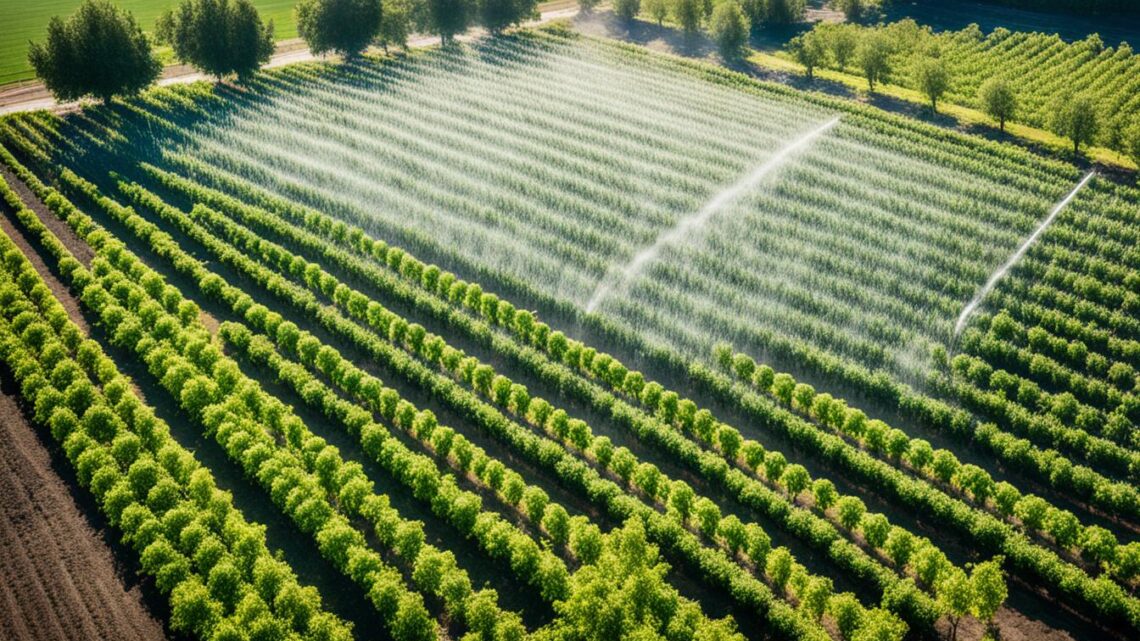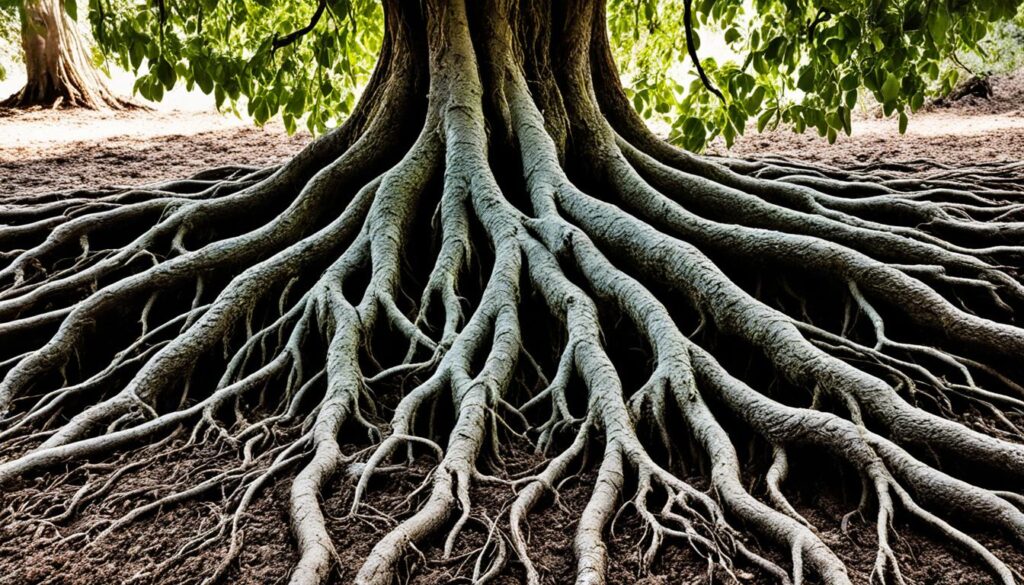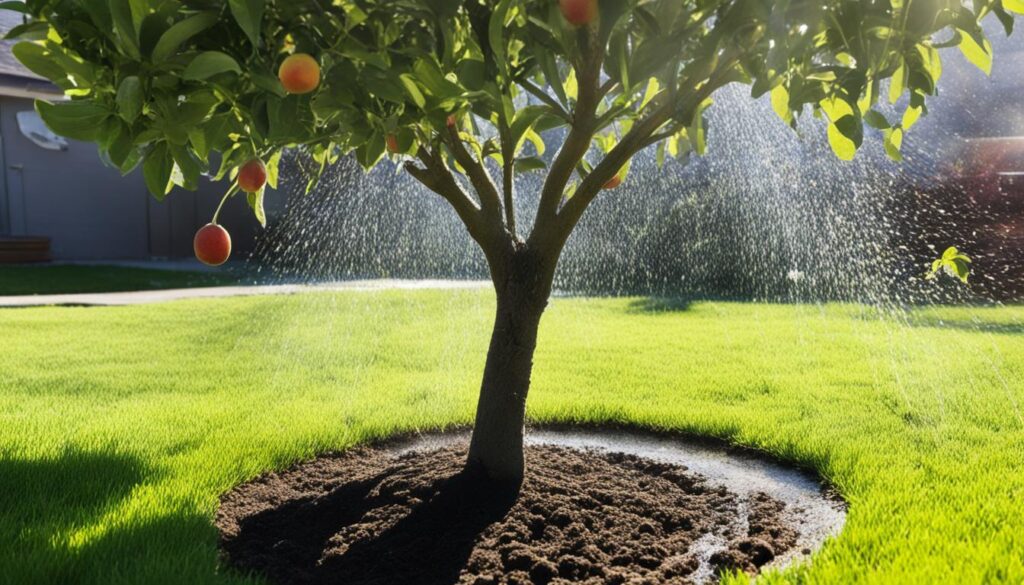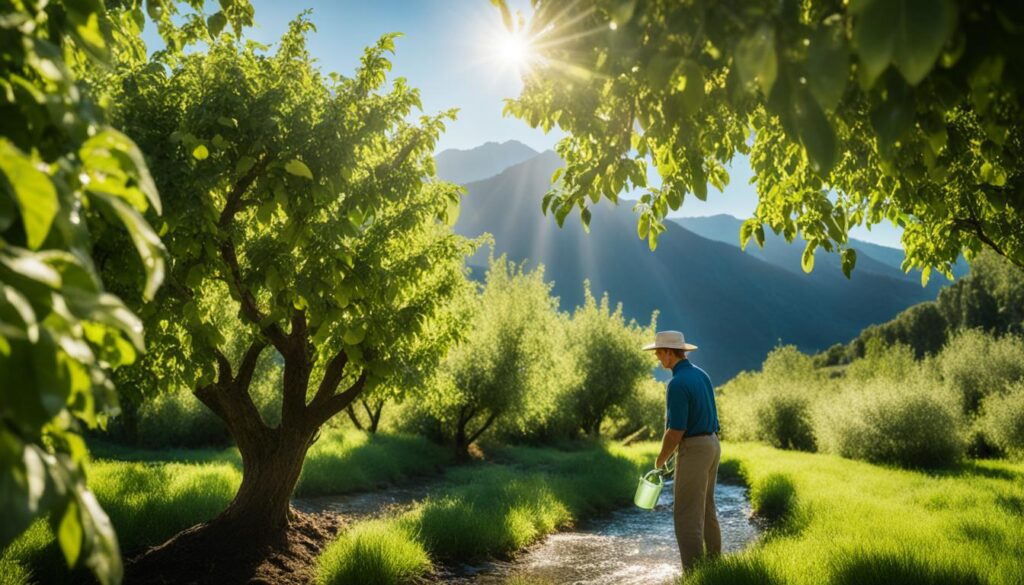
Are you having trouble keeping your fruit trees healthy and productive? The secret to a great orchard might be in how you water them. Proper watering is key for fruit trees to grow and produce well. We’ll cover why water is vital for fruit trees, share tips for watering both young and mature trees, and show the best ways to water your orchard.
Importance of Proper Watering for Fruit Trees
Keeping the right amount of water is key for your fruit trees’ health and fruit production. Fruit trees can’t chew their food. They get all their nutrients through their roots. If they don’t get enough water, they can’t get the nutrients they need.
Dehydrated Trees are Nutritionally Deficient
Not enough water makes fruit trees dehydrated and lacking in nutrients. This can slow down the tree’s growth, cut down on fruit, and make it more likely to get pests and diseases. It’s important to water your fruit trees right to help them grow and produce well.
Water Uptake Occurs Through Roots
The youngest roots of fruit trees, called feeder roots, take in most of the water and nutrients. These roots are key for the tree’s growth and making fruit. Keeping these roots moist is crucial for the tree’s health and fruit production.
| Fruit Tree Type | Watering Needs |
|---|---|
| Apple | Established trees in rainy zones don’t need watering, but may need deep soaks in dry summers. |
| Pear | Planted in regular soil, need watering twice a week; in clay soil, only once a week. |
| Peach | Should be watered at least weekly during the first year. |
| Orange | Require twice-weekly watering initially, then deep watering every two weeks once new growth shows. |
Knowing the water requirements for fruit trees and how water uptake occurs through their roots helps your orchard do well. This way, you can make sure your trees get enough water and produce lots of fruit.

Watering Young and Newly Planted Fruit Trees
It’s key to help young fruit trees grow strong roots for their health and productivity. Water them often for the first 2-3 months after planting. This helps them settle and build a strong base. Sandy soils need more water, while clay soils should get deeper, less frequent water.
Establishing Root Systems in Young Trees
New fruit trees need a gallon of water every 7 days during the growing season. This helps their roots grow deep into the soil. Deep, slow watering makes sure the roots get enough water.
This kind of watering helps create a strong root system. It’s important for taking in nutrients and water. This leads to a healthy tree that grows well.
Watering Frequency and Quantity for New Trees
The right amount of water for young fruit trees depends on the soil and climate. Generally, they should get a deep watering once or twice a week. Adjust how often you water to avoid giving them too little or too much water.
In soils that drain well, trees might need more water. But in heavy clay soils, give them less water but deeper. This prevents the roots from getting too wet.

Watering right is key to helping young fruit trees grow strong roots. This sets them up for success in your garden. By knowing what they need, you can help them grow and look forward to a big harvest later.
Watering Mature Fruit Trees
As fruit trees grow, their roots spread out a lot. The main roots that grab water are often under the tree’s canopy edge. To water them right, aim the water at these roots, not just the trunk. Watering a bit farther from the trunk each year helps the roots grow wider, making the tree stronger and more fruitful.
Understanding Feeder Roots and Watering Patterns
In hot, dry places like central Victoria, Australia, mature fruit trees need about 200 litres of water a week in summer with a full crop. The tree’s age, how much fruit it has, the soil, ground cover, temperature, and wind affect how much water it needs. Checking and keeping drippers working well is key for watering systems. It saves water and makes watering trees easier.
| Irrigation Method | Efficiency in Delivering Water to Fruit Trees |
|---|---|
| Drip Irrigation Systems | More efficient in delivering water to the root zone effectively, reducing wastage |
| Soaker Hoses and Dripping Hoses | Effective in targeting the root zone, but may require more maintenance |
| Leaky Bucket Technique | Simple and low-cost, but may be less efficient in water delivery |

Setting up a watering system for mature fruit trees means figuring out how much water they need, finding water sources, and creating a good way to spread the water. You also need to pick the right drippers or mini-sprinklers and use timers for watering on a schedule. New trees need checking every week to make sure they get enough moisture for growth.
Avoiding Overhead Watering with Sprinklers
When watering your fruit trees, don’t use overhead sprinklers. They can spread water to the trunk, branches, and leaves. This can lead to harmful fungal diseases. It’s better to water directly at the roots.
Overhead sprinklers soak the leaves and bark of your trees. This can cause problems like:
- Increased risk of fungal diseases like powdery mildew, leaf blight, and root rot
- Wasted water due to evaporation and runoff
- Potential for nutrient loss and erosion
To make sure water goes to the roots, try drip systems or the leaky bucket technique. These methods avoid wetting the leaves. They make watering your trees more efficient and effective.
| Irrigation Method | Water Efficiency | Disease Risk | Cost |
|---|---|---|---|
| Overhead Sprinklers | Moderate | High | Low |
| Drip Irrigation | High | Low | Moderate |
| Leaky Bucket Technique | High | Low | Low |
By not using overhead sprinklers and choosing targeted watering, your fruit trees will stay healthy. You’ll save water and lower the risk of diseases.

Effective Irrigation Methods for Fruit Trees
Keeping your fruit trees healthy means paying attention to how you water them. Drip irrigation, soaker hoses, and the leaky bucket method are great choices. They send water straight to the roots, cutting down on evaporation and saving water.
Drip Irrigation Systems
Drip irrigation is a top choice for watering drip irrigation for fruit trees. It sends water slowly and right to the roots. This helps trees grow deep roots and saves water. To set it up, lay drip lines beside trees or around them. Make sure emitters are a foot apart for sandy soil or more for clay.
Soaker Hoses and Dripping Hoses
Soaker hoses for fruit trees and dripping hoses for fruit trees are great too. They slowly release water, giving trees a steady supply of moisture. They don’t waste water like sprinklers do, sending it straight to the soil.
Leaky Bucket Technique
The leaky bucket technique for fruit trees is easy and works well. Drill holes in buckets and put them around the tree’s drip line. The slow leak waters the roots well and controls how much water goes out.
Using these methods, you can make sure your fruit trees get the right amount of water. This leads to healthy trees and lots of fruit.

Mulching for Water Retention and Weed Suppression
Putting a 2-inch layer of wood mulch around fruit trees is great. It keeps soil moist and stops weeds. This mulch acts like a shield, keeping water in and reducing watering needs. It also stops weeds by blocking light and preventing seeds from growing.
Make sure to spread the mulch to where the feeder roots are. This lets the roots get the moisture they need. But don’t put mulch too close to the trunk, as it can cause rot and let pests in.
Proper Mulch Application Around Fruit Trees
When mulching fruit trees, finding the right balance is key. An MSU study found that organic mulch keeps soil temperatures steady. This helps keep moisture in and reduces loss. The kind of mulch you use matters too, as different types last longer or break down faster.
- Apply a 2-inch layer of organic mulch, like wood chips or pine needles, around your fruit trees.
- Pine needles have chemicals that stop weed seeds from growing and add nitrogen as they break down.
- Use 3-4 inches of mulch in new beds at first, then add only 1 inch each year to avoid root rot and too much moisture.
- Don’t pile mulch too high around the trunk, as it can cause root rot, bug problems, and slow tree growth.
Proper mulch application for fruit trees is crucial for their health and productivity. It keeps soil moist and controls weeds, helping your trees grow well.
Seasonal Watering Considerations
Looking after a fruit tree orchard means paying attention to when and how much water they need. The amount of water trees need changes a lot with the seasons.
In the cold winter, trees grow less and usually don’t need more water. But in warmer places, trees like citrus might need water to stay healthy.
When spring comes, the ground is often wet from rain. But watch out for dry times. Your trees might need extra water to grow strong roots.
Summer is the key time for seasonal watering for fruit trees. The sun and dry air can dry out the soil fast. So, watering your trees well is key for lots of fruit and healthy trees.
As fall comes, start cutting back on watering fruit trees in different seasons. This helps trees get ready for sleep time. It also keeps them safe from cold damage in winter.
Knowing what your fruit trees need all year helps you keep your orchard healthy and full of fruit. This way, your trees can handle the seasons well.
Monitoring Soil Moisture Levels
Keeping the right amount of moisture in the soil is key for your fruit trees’ health and growth. To make sure your trees get enough water, check the soil moisture often. Dig a small hole near the tree’s drip line and feel the soil 6-12 inches down.
If the soil feels dry, your trees need more water. By checking soil moisture often and adjusting how much you water, you help your trees grow strong and produce lots of fruit.
Here are some tips for checking soil moisture well:
- Use multiple sensors at different depths (1 foot, 2 feet, 3 feet) to get a full picture of the soil’s moisture.
- Put sensors in spots that show the variety of your orchard, like soil type, land shape, and how close the trees are planted.
- Get the sensor info online through cell networks or Bluetooth, so you can check and change your watering right away.
- Look at the data to see how much water is in the soil (%) or the soil’s water level (centibars) to know when to water.
- Keep the soil moist but not too wet or dry for the best growth and fruit.
| Soil Type | Readily Available Water | Optimal Sensor Reading |
|---|---|---|
| Sandy Loam | 1.8-2.25 inches at 3-feet depth | 50-70 centibars at 50% depletion |
| Clay Loam or Clay | N/A | 90-120 centibars |
By closely monitoring soil moisture for fruit trees and adjusting your watering as needed, you can keep your orchard healthy and full of fruit every year.
Watering Fruit Trees for Optimal Fruit Production
Watering fruit trees right is key for their health and fruit production. Consistent, deep watering helps trees grow strong roots. These roots support the tree’s growth and fruit yield. Meeting the tree’s water needs during key growth stages ensures a big, quality harvest every year.
During the growing season, water fruit trees deeply for 30 to 45 minutes, 2 to 3 times a month. Start watering when the top couple inches of soil around the tree are dry. This helps young trees grow strong roots for better fruit production later.
Mulching around fruit trees keeps soil moist and controls temperature. This cuts water use for irrigation by 12%. Using these watering tips and other methods helps trees reach their full potential. This leads to more fruit each season.
Pruning fruit trees in the off-season boosts fruit production by 20%. It also makes fruit quality better. Regular pruning cuts disease spread by 30% and makes tree structures stronger. This reduces branch breakage by 10% during fruit seasons.
By watering and caring for fruit trees well, growers can create the best conditions for lots of fruit. This ensures a healthy orchard for many years.
Additional Fruit Tree Care Resources
For those looking to learn more about fruit trees, there are many great resources. Susan Poizner, the founder of OrchardPeople.com, is a top expert in urban orcharding. Her book «Growing Urban Orchards» and online guides offer lots of advice on planting, pruning, and managing pests.
Podcasts like «Pioneering Today» also offer great tips from fruit tree experts. They cover everything from planting to pest control for home orchards. These fruit tree care resources are great for both new and experienced growers.
If you’re starting a new orchard or want to improve your trees’ health, these additional resources for fruit tree growing are perfect. They offer great advice and insights to help you succeed. Check out these educational tools to improve your fruit tree care skills.
Conclusion
This guide has given fruit tree growers the best ways to water their trees. It covers everything from starting with young trees to keeping mature ones healthy. Knowing how much water trees need is key for a good harvest.
Using drip irrigation systems, soaker hoses, or the leaky bucket method is important. These methods send water straight to the roots slowly and deeply. Adding mulch and thinking about the seasons also helps trees get the right amount of water.
Right watering methods, like checking soil moisture and using efficient systems, make trees healthier and more productive. Taking good care of your trees means your orchard will do well year after year.
For a successful fruit tree garden, know what your trees need and water them right. Being careful and proactive with watering and care makes your trees grow well. This way, you get a lot of fruit from your trees.



